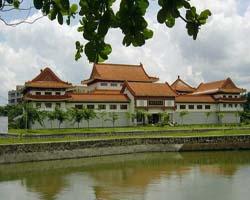
The Wugong Temple was built during the reign of Emperor Wanli in Ming Dynasty (1368~1644AD), had been rebuilt during the reign of Emperor Guangxu in Ch'ing Dynasty (1616~1911AD) and was renovated several times later. It was built in order to commemorate the five historic figures who were banished to Hainan Province in Tang Dynasty (618~907AD) and Song Dynasty (960AD~1279AD). The five celebrities were Tang Prime Minister Li Yude, Song Prime Minister Li Gang, Li Guang, Zhao Ding, and a famous official named Hu Quan.
Five kilometers away from Haikou City, the Wugong Temple houses some rare cultural relics of Hainan Island such as the Forbidden Bell in Ming Dynasty, the ancient copper drum, and Xuande Stove of Li people. It is an ancient complex and covers more than 2,800 square meters, The main buildings are Guanjiatang (Watching Crop Hall), Xuefutang (Studying Hall), Dongzhai (East Room), and Xizhai (West Room), unified with another scenic spot - Sugong Temple as a whole.
The Wugong Temple has been called "Jade Terrace and Wonder Land" for a long time. Its main body is the Watching Crop Hall. The hall enjoys the reputation of "number one tower" in Hainan. The red tower was built with fine woods. It has two stories, more than 10 meters high. The crooked roof, black tilt, red pillar, and the green trees add pleasure to each other.
In the main hall houses there are huge lifelike stone statues of the five celebrities. Climbing on the second floor, there is a horizontal tablet inscribed with "The First Tower in Hainan" hanged on the wall. The antithetic couplet on the inner pillars downstairs relates the great deeds the five men did for the country and expresses admiration from the later generations.
Xuefutang (Studying Room) was the ancient place where the great Ch'ing scholar Guo Wanxiang gave lectures; To the right, Wugong Jingshe (The Refined House of Five Lords) used to be the place where the students from Hainan Province at the end of Ch'ing Dynasty studied history and poem, they are both in a typical Ming and Ch'ing style with a black tilt and red wood construction.
Dong Po Temple
Dong Po Temple is located in the east of the Wugong Temple. Built in Ming Dynasty this a tall building used to offer sacrifice to Su Dongpo who had made a great contribution to the locals. There is a stone statue of Su Dongpo in the temple.
When Su Dongpo was banished to the island, he was considered as the common people. After he knew the difficulty of getting drinking water, he ordered to dig Fusuquan (Floating Millet Spring) and the Xixinquan (Cleaning Heart Spring). The water in the Floating Millet Spring is sweet and clear. Its surface is suffusing with little bubbles, which look like seeds of millet.
Accordingly it was named Floating Millet Spring. When the local government renovated the Sugong Temple in 1915, they built Millet Spring Pavilion, Cleaning Heart Pavilion, Cave Corridor and named them Qiongyuan (Jade garden) in all.
